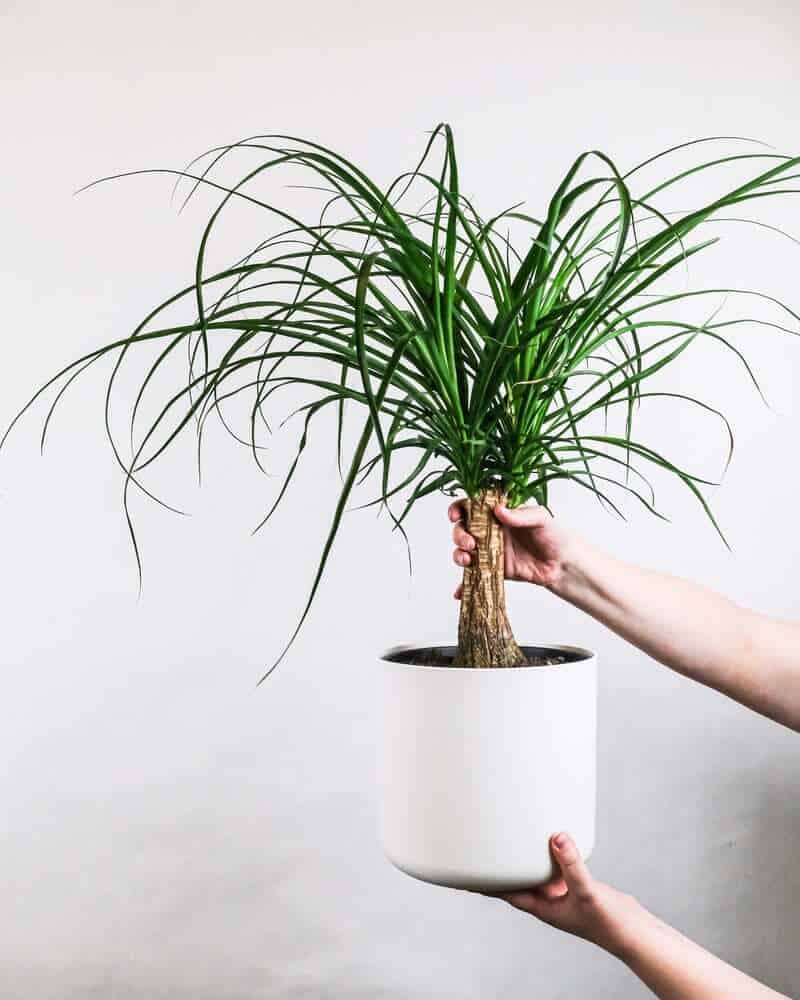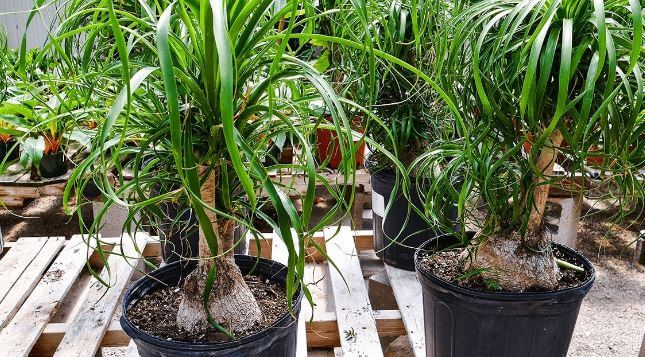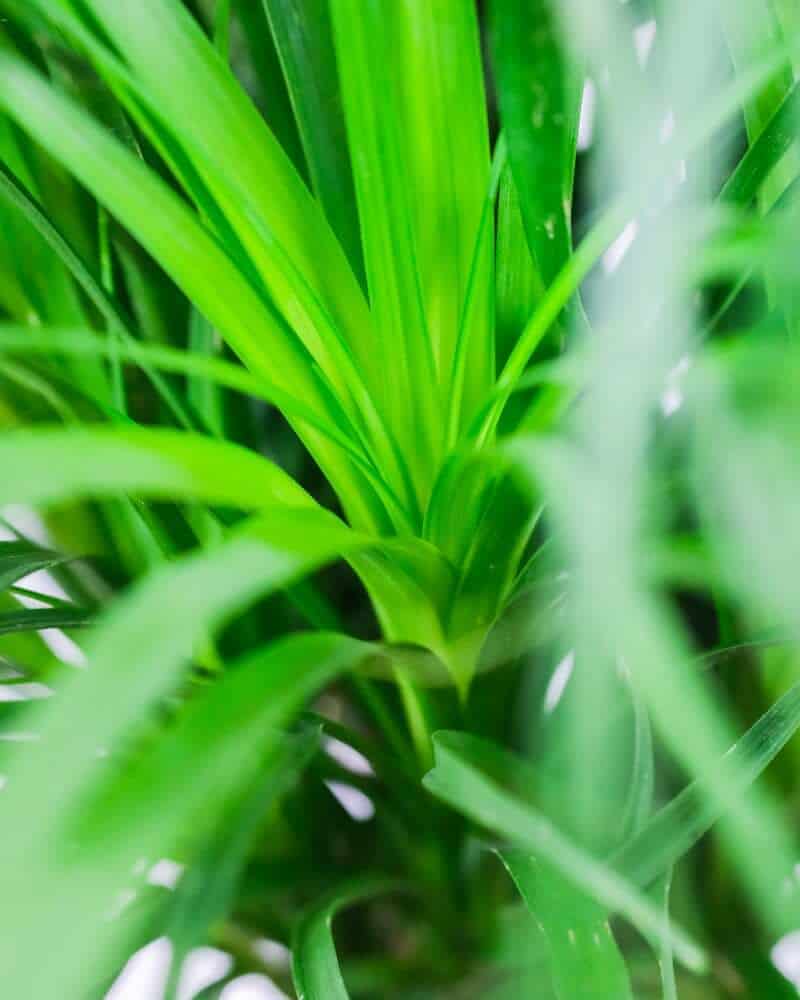Last Updated on June 4, 2023 by a Friendly Gardener
If you’re looking for an original and somewhat unique plant that is easy to cultivate, the Beaucarnea Recurvata, popularly named“Ponytail Palm” is a happy addition to any space. If it is grown outdoors this houseplant will become an impressive tree with heights of thirty feet towering over whatever surrounds it.
Also referred to as the Elephant’s foot, it belongs to the Asparagaceae family. Despite its appearance, the Ponytail Palm is not a palm and interestingly enough it is related to asparagus. It is closely related to desert vegetation including the Agave and Yucca plants.
A stump form acts as the base of the tree’s trunk. This trunk tapers off becoming thinner towards its top. The plant top features rosettes of long slender grass-like green leaves that may even curl a bit at the end. These leaves resemble a ponytail hence the name. Outdoor leaves can grow as long as six feet.
As an indoor houseplant, the Ponytail resembles a small tree with a bulbous stem and a canopy of arching green foliage. With maturity, the tree can reach six feet in height in the proper conditions with individual leaves reaching an impressive three feet.
The Ponytail palm finds its natural habitat in the more arid regions of Central America. It is an evergreen tree that is, actually, a succulent.
Ponytail Palm Plant Care

This is a slow-growing succulent that boasts a long lifespan, often outliving its owners. It may need as many as five years to double its size when cultivated indoors. They can be planted and cultivated year-round when cultivated indoors and should ideally be planted in shallow dishes or containers. If planting a Ponytail Palm outdoors, do so in the springtime.
This is the perfect plant for beginners, travelers, or people without much time. You can plant it and then forget about it without doing much harm. It requires good light and regular watering above all during its growing season.
Soil
Being a native of Central American arid, semi-desert regions, the Ponytail needs a sandy soil bed that is rich in nutrients and organic matter both indoors and out. If you cultivate this species as an indoor plant, use a cactus or succulent potting mix with a little peat added.
You can mix your plant’s growing medium by blending one part potting mix, one part sand, and one part perlite. Select a pot with a sufficient number of drainage holes for excess water. Clay or terracotta containers are ideal due to their porous texture. They aid in wicking away moisture from the soil bed more rapidly.
Light

Full bright sunlight is ideal for these trees, but your Ponytail will thrive with bright indirect light. Position your Ponytail palm in or near a sunny window.
Water and Humidity
The Ponytail Palm will require a watering week or bi-weekly during its growing season. Its characteristic bulbous trunk will store water for its survival. Be careful not to overwater. In the winter, watering can be reduced to monthly. Soil beds should be allowed to dry out from one watering to the next.
Ponytail Palms can be soaked under a faucet or garden hose, but all excess water must drain afterward. This particular plant should not be left standing in water.
When cultivating a Ponytail Palm outdoors, it will not need to be watered if there is some rain regularly. In arid climates or zones subject to drought, water your plant every other week.
Temperature
These Central American natives thrive in dry warm temperatures that normally measure above 60° Fahrenheit. Temperatures that drop down to 50° F. can be tolerated, but not for prolonged periods.
During winter, avoid leaving your palm near a window if nighttime temperatures are cold. Ponytail palms can suffer damage when exposed to freezing temps. They also should be protected from drafts and air conditioning or heating vents, as this can dry out the foliage.
In the summer, you can put your palm outside in a yard, or on a deck, patio, or porch. Moving the Ponytail from indoors to outdoors happen gradually. If nighttime temperatures drop to 50°F, move your plant inside.
Feeding
Your Ponytail palm will be happy with a weekly feeding during the growing season. Use a liquid fertilizer diluted to half-strength. Reduce feeding in the winter.
Pruning
Damaged foliage can be pruned back to healthier tissue. Unwanted pups or offsets with secondary shoots can also be pruned away to concentrate the plant’s energy on the central trunk. If your Ponytail has a single stem, avoid pruning the palm itself as this exposes the trunk to mildew and rot.
Repotting

Repotting a Ponytail palm should be done at the beginning of spring. To encourage size growth, repot it annually. To maintain a small tree or houseplant appearance, repot it every two or three years.
Ponytail Palms do exceptionally well in containers that bind roots somewhat, so it’s not mandatory to move your palm to a larger-sized pot during repotting. If repotting, use a new container that is only an inch larger at the most than the old one.
Moving these plants to bigger containers can cause excess water retention in the soil. Remember when repotting this plant, that foliage has serrated edges. Gardening gloves are recommended.
Ponytail Palm Propagation

Propagation is facilitated if pups or offsets grow at the plant’s base. These pups usually do not have roots but can be cultivated in individual pots. The pup should reach four inches in height. Snip off the pup and allow the cut to heal. Coat the cut end with a rooting hormone and move it to its pot.
Indoors Ponytail palms do not usually flower, so seed production is even rarer. Ideally, seeds should be used to propagate if they can be found. Seeds can be sown in the spring when temperatures reach 68° F. or higher.
Ponytail Palm Toxicity
The ASPCA (American Society for the Prevention of Cruelty to Animals), informs us that the Ponytail Palm is not toxic to dogs, cats, horses, or humans.
Pests, Diseases, and Problems
A Ponytail Palm is susceptible to visits from scale, mealybugs, and spider mites. Insecticidal soaps or organic neem oil can be applied to treat pest infestations.
These plants are at risk for a few diseases including leaf spots, bacterial leaf streaks, and stem rots. Rotting and fungal infections are generally caused by overwatering.
Another common problem is brown leaf tips. They can be caused by underwatering, overwatering, overfeeding, or salt buildup in the soil. Trim off brown tips. When leaves turn yellow and drop, it is due to a drainage block or overwatering. When underwatering leaves will turn brown and crispy.
Outdoor Cultivation of the Ponytail Palm

Growing a Ponytail Palm outdoors is possible in warmer climates only. Outside, this plant needs direct sunlight exposure. When transplanting a houseplant outdoors, gradually expose the palm to outdoor light and temperatures, increasing the time spent outside daily. Do this for several weeks before transplanting.
Outdoors, a Ponytail palm thrives in full sunlight and with a generous occasional watering. The tree stores water in its trunk, so frequent watering is not advised. The location should guarantee well-draining soil. The Ponytail risks root rot if allowed to sit in soggy soil. Clay-based soils are ill-advised.
Ponytail palms require years for branching out. Mature, established palms will produce flowers.
A Final Thought
With its delightful curly foliage and forgiving nature, the Ponytail Palm is a low-maintenance, appealing plant that can bring a bit of brightness and fun to any interior décor. Ideal for beginners, or those with little time, bring a smile to someone as this plant makes a lovely gift.
